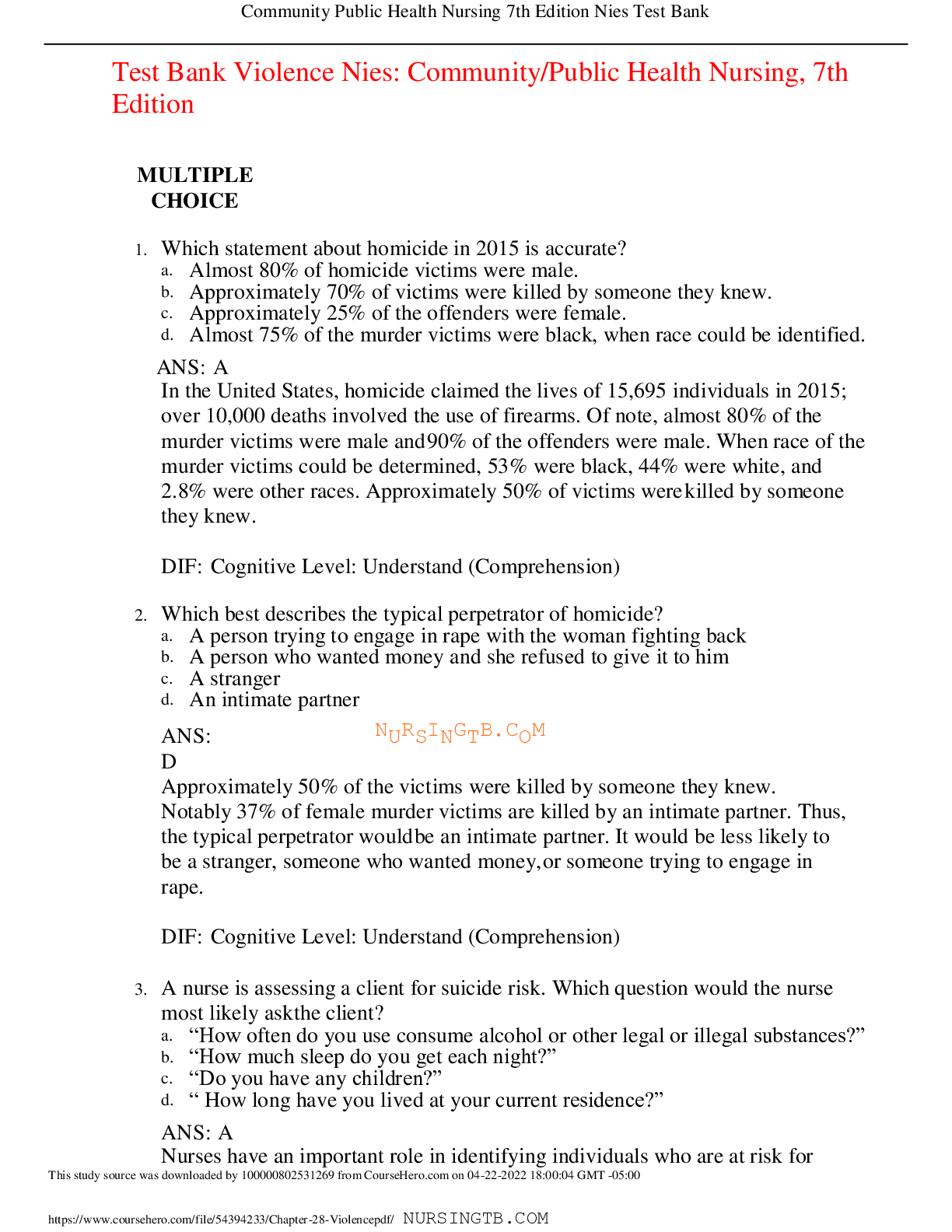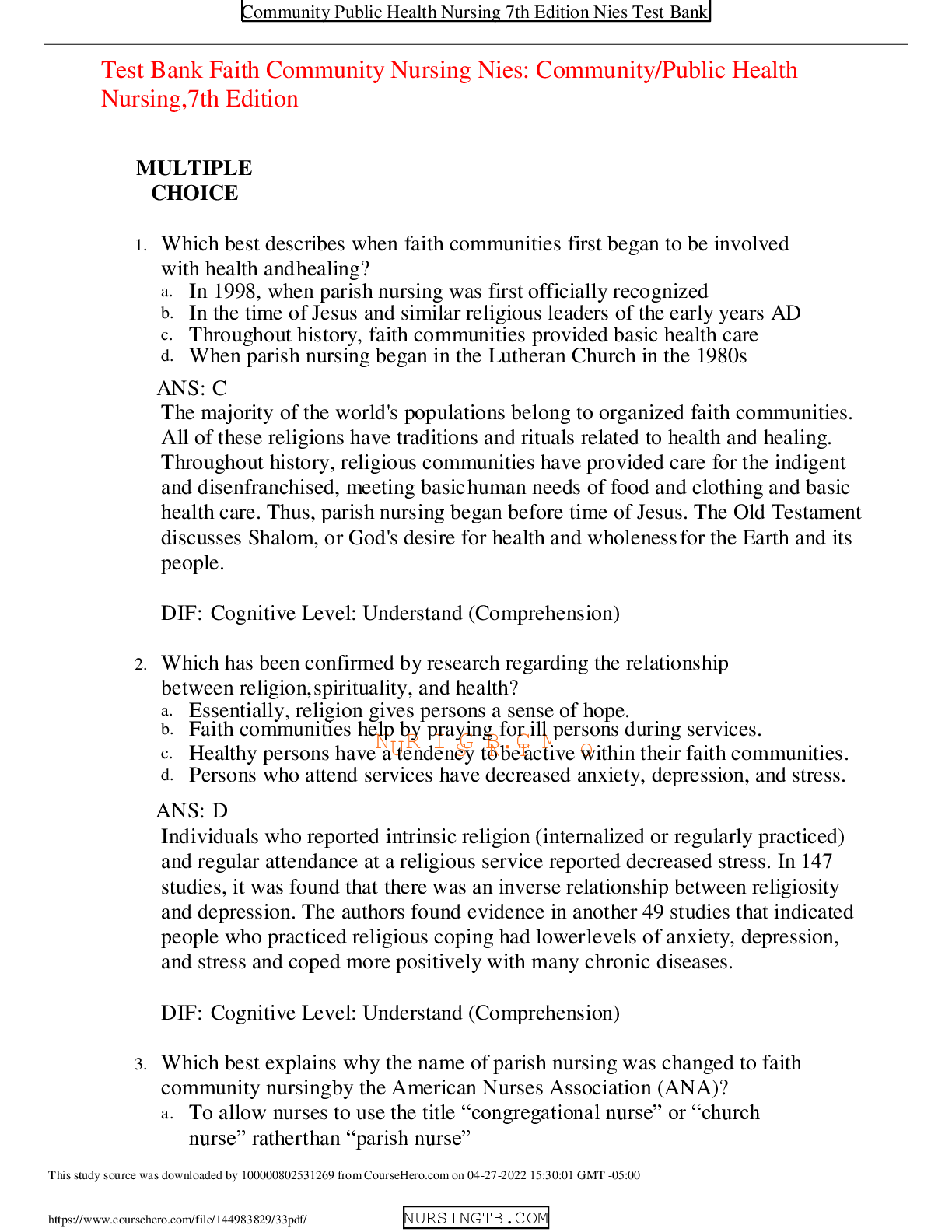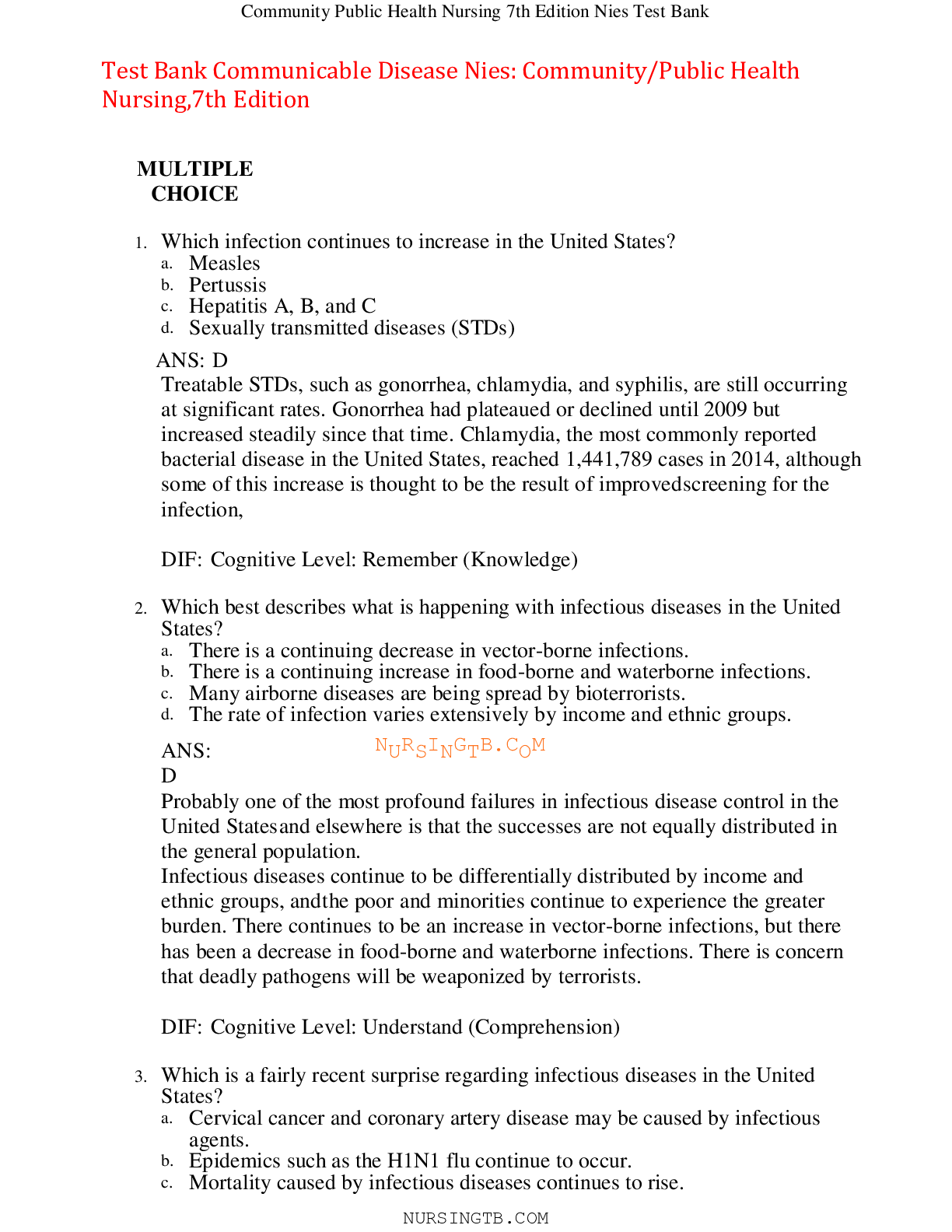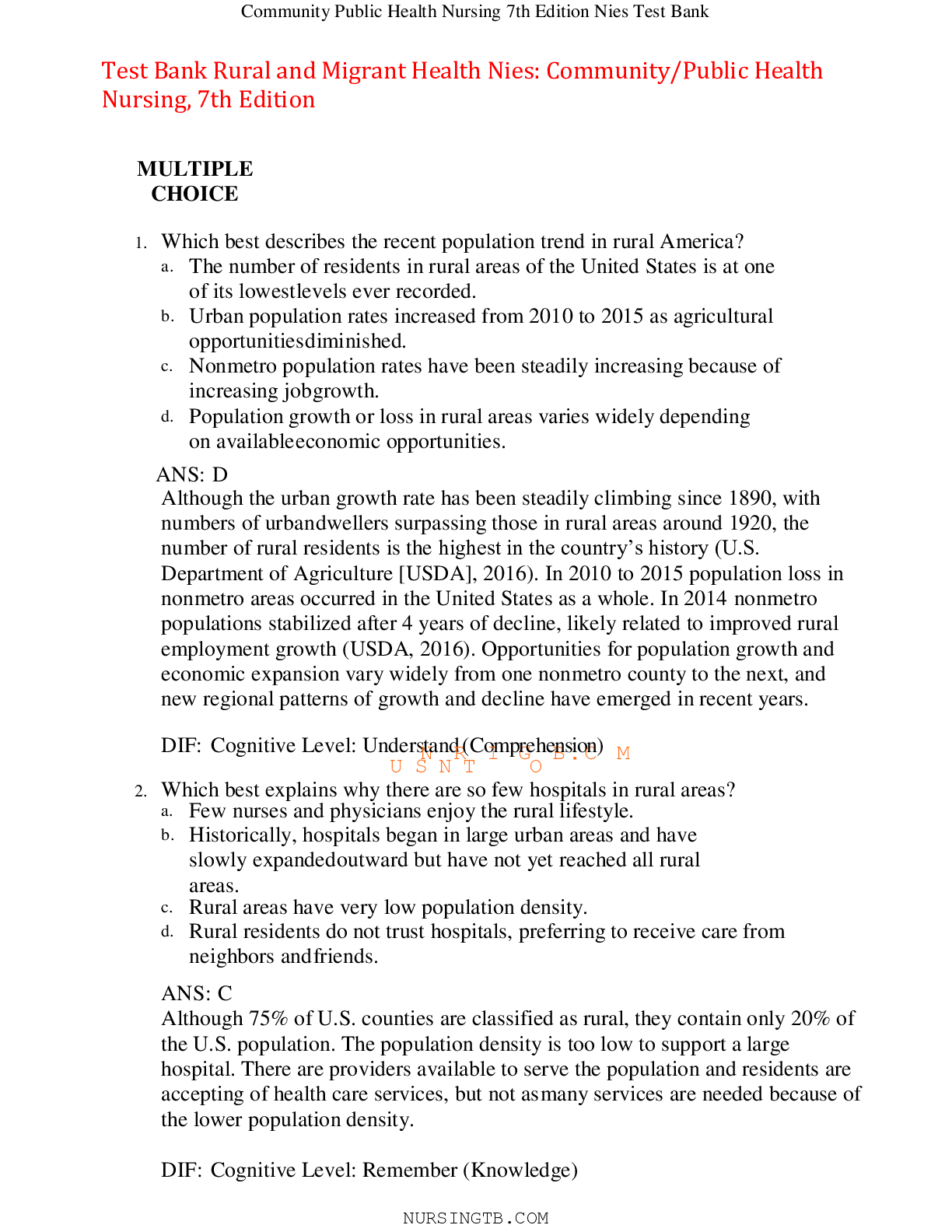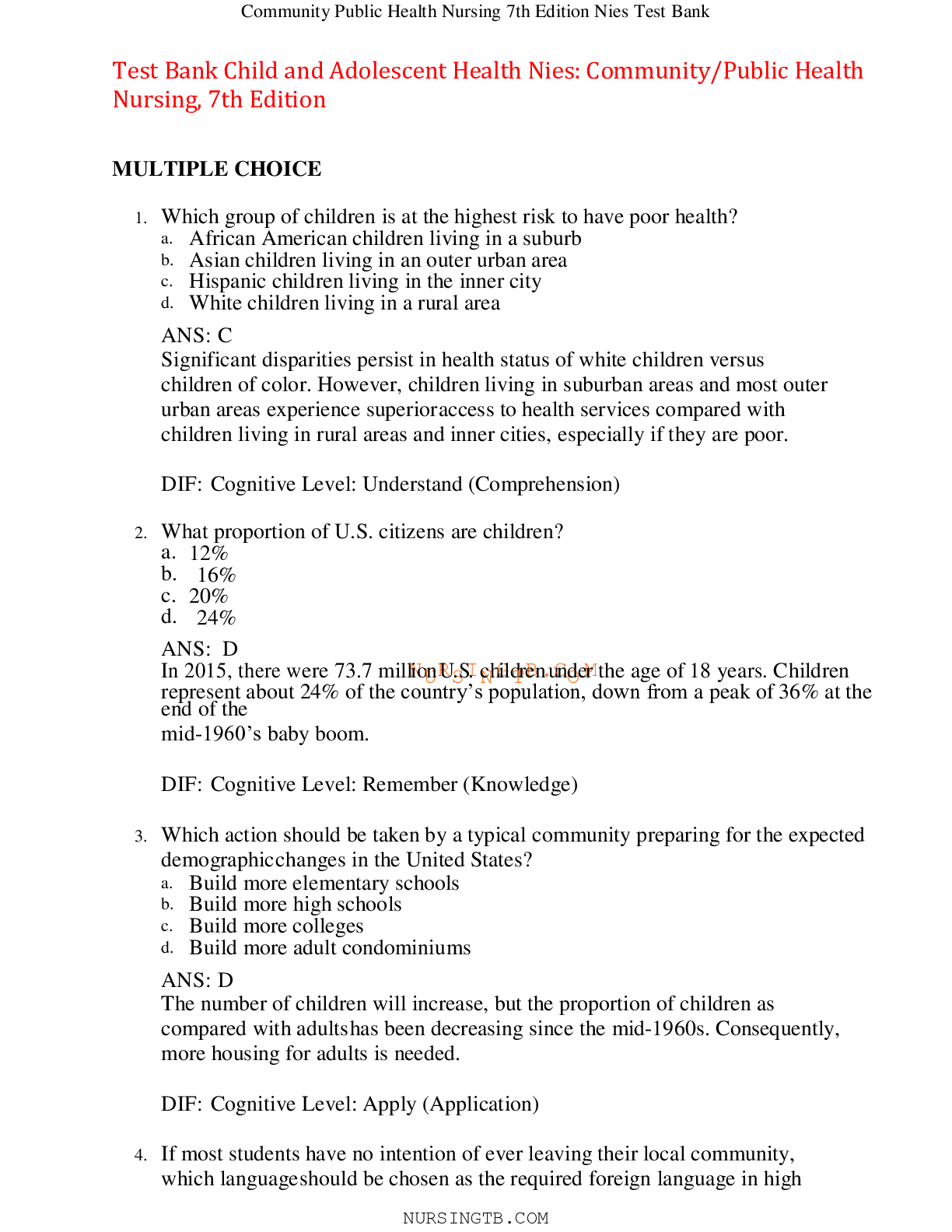*NURSING > TEST BANK > Test Bank Case Management Nies: Community/Public Health Nursing, 7th Edition,100%CORRECT (All)
Test Bank Case Management Nies: Community/Public Health Nursing, 7th Edition,100%CORRECT
Document Content and Description Below
Test Bank Case Management Nies: Community/Public Health Nursing, 7th Edition MULTIPLE CHOICE 1. A health care provider has charged more than what is allowed by a third-party payer. Which would... most likely be the result? a. Provider may be removed from the list of providers for the third-party payer. b. The third-party payer will reexamine the payment for that procedure. c. Provider would get the typical payment instead of what was charged to the third-party payer. d. The third-party payer would be forced to increase its typical payment for that procedure. ANS: C Client service use reflects a greater emphasis on health care costs. Third-party payers evaluate the appropriate use and costs of health care resources. Therefore, at least on the first occasion, the most probable result would be that the provider gets the listed payment, not what the provider charged. DIF: Cognitive Level: Apply (Application) 2. A nurse is explaining case management to a client. Which statement would be the most appropriate for the nurse to make? a. “We assess, plan, facilitate, and advocate to save money as much as possible.” b. “We coordinate your careNsoRyouIobtGainBne.eCdedMservices without incurring undue costs.” U S N T O c. “We seek the lowest cost provider to give you what care is necessary.” d. “We collaborate with you to coordinate your care for the best outcome.” ANS: D There is no single definition of case management. But it is a collaborative process to meet an individual’s health needs through communication and available resources to promote quality cost-effective outcomes. The response “with you” shows a collaborative approach to coordinating care for the best outcome. DIF: Cognitive Level: Apply (Application) 3. A hospital is going to start a care management program. Which group of clients would most likely be selected to first receive such services? a. Clients who represent the most common diagnosis group to be admitted b. Clients who request such services from their local hospital c. Clients with chronic illnesses d. Clients with the least education ANS: C The overall goal of care management is to improve the coordination of services provided to clients who are enrolled in a care management program. Examples of groups of people who may be served by care management services include the elderly, children from low-income families who receive Medicaid services, and groups of people with chronic illnesses. The other groups do not represent groups who are typically enrolled in a care management program. DIF: Cognitive Level: Apply (Application) 4. Who first created the idea of a continuum of care, which later evolved into the term “case management”? a. Florence Nightingale, when she engaged in activities such as writing letters for the wounded. b. Lillian Wald, who created health education programs for the whole community. c. Social workers, who function as discharge planners, use the term. d. Those who coordinated services for discharged psychiatric patients after World War II (WWII) used the term. ANS: D The concept of continuum of care originated after WWII to describe the long-term services required for discharged psychiatric patients. The term “case management” first appeared in social welfare literature during the early 1970s. Nightingale, Wald, and social workers were not involved in the creation of the idea of the continuum of care. DIF: Cognitive Level: Remember (Knowledge) 5. Which best describes the afteNrmaRth oIf thGe deBin.sCtitutMionalization of mentally ill patients into the community during the 1970s? U S N T O a. Community health centers were created and gave care to such clients. b. Families were eager to accept their family members back home. c. Many mentally ill clients without social skills ended up in nursing homes. d. Without follow-up care, many clients were readmitted to care. ANS: D Several problems resulted from deinstitutionalization of mentally ill patients, because there was no follow-up or monitoring. Many were readmitted to state hospitals. Many ended up homeless or in prison facilities, not in nursing homes or with their family members at home. Community health centers were created to provide care to these patients, but the deinstitutionalized were unable to meet their basic needs and receive proper follow-up and health care monitoring. Thus, they were readmitted to care. DIF: Cognitive Level: Understand (Comprehension) 6. Which elderly persons are often the targets of case management? a. Those who are homebound and have multiple complex problems b. Those who live alone without close relatives c. Those who show clear evidence of mental and physical decline d. Those with chronic long-term health problems needing pharmaceutical intervention ANS: A Many older people have special, population-specific health care needs. Case management services frequently target the elderly population, specifically homebound individuals or those with complex problems. However, not all older persons require a case manager. The other elderly groups are not the primary target of case management services. DIF: Cognitive Level: Understand (Comprehension) 7. Which best describes the purpose of case management from the client’s perspective? a. To help clients navigate a complex, fragmented, confusing health care system to obtain appropriate care b. To help clients recognize that health care resources are limited and must be used wisely c. To help clients understand their varied health problems and the best approach to maintain their health d. To help clients obtain whatever care they need or desire ANS: A Client-centered case management assists the patient through a fragmented and often confusing health care delivery system and to achieve specific client-centered goals. Systems-centered processes recognize that health care resources are finite. Helping clients understand their health problems is a responsibility of health education, not case management. DIF: Cognitive Level: Understand (Comprehension) 8. Which best describes a key strategy that is used as part of care management? a. Align necessary services with the need of the population b. Implement services as soNon aRs poIssibGle B.C M c. Request front line staff makUe aSpproNpriTate refeOrrals d. Utilize assigned case managers to complete this process ANS: A The purpose of care management is to reduce health risks and cost of care for a defined population. AHRQ highlights three key strategies to enhance care management for target populations: (1) Identify population(s) with modifiable risks; (2) Align CM services to the needs of the population(s); and (3) Identify, prepare, and integrate appropriate personnel to deliver the needed services. DIF: Cognitive Level: Understand (Comprehension) 9. Which best describes why utilization review departments are becoming case management units? a. Funding is available for case management responsibilities. b. Monitoring service use alone does not improve patient outcomes. c. It facilitates using nurse experts for case management. d. It promotes the current trend of naming “utilization review” units “case management.” ANS: B Case management programs evolved from utilization review departments when those departments demonstrated that monitoring service use alone is insufficient for managing patient populations with diverse resource needs. There is not readily available funding for case management responsibilities. Case management involves more than utilization review, so there is a changing role of the nurse associated with the change of the name of the department. Using nurse experts for case management is beneficial, but it is not the reason why these departments transitioned. DIF: Cognitive Level: Understand (Comprehension) 10. Which best describes why health care institutions are unhappy beyond the fact that they are not receiving the previous high reimbursement for procedures from Medicaid or Medicare? a. Because clients are well informed and know they do not really have to pay their hospital bills b. Because insurance companies and other third-party payers copy Medicaid’s approach to holding down costs c. Because it is harder to continue giving charity care when less reimbursement is received from the federal government d. Because recent legislation has required that all reimbursement be based on quality performance measures ANS: B Although publication of quality measures is occurring, this is gradually being implemented. The Centers for Medicare and Medicaid (CMS) have established value-based purchasing programs for hospitals. The programs link Medicare payments to quality performance, utilization of evidence-based practices, costs of care, and patient experience scores. However, whatever the federal governmNentRdoeIs toGhoBld.dCownMcosts is usually quickly copied by insurance and other third-partyUpaySersN. T O DIF: Cognitive Level: Understand (Comprehension) 11. Which best describes why nurses are increasingly becoming case managers when social workers have historically been so successful in the role? a. Because of the need for ongoing patient assessment. b. Because of a shortage of licensed social workers. c. Nurses seek such roles as being easier than direct clinical care. d. Social workers expect higher salaries than nurses in the same role. ANS: A Traditionally, case managers were social workers. Client health care needs became more complex, the need for ongoing patient assessment has emerged, and available resources have become more numerous and diverse. Therefore, nurses have become case managers. There is not a shortage of licensed social workers to fill these roles or a salary issue with social workers being in these roles. These roles are different than direct clinical care but may not be considered to be an easier role for the nurse. DIF: Cognitive Level: Understand (Comprehension) 12. A very skilled baccalaureate-prepared clinical nurse was asked to assume a case manager role. Which will be most difficult for the nurse new to this role? a. Having the ability to be a leader and work autonomously b. Obtaining knowledge of community resources c. Gaining knowledge of reimbursement structures and financial strategies d. Getting practice at evaluating patient outcomes ANS: C Skills to ensure success in the role of case manager include sound knowledge of reimbursement structures, knowledge of available resources within the community, ability to evaluate patient outcomes, and an understanding of financial strategies. Such a nurse would have to be flexible, be creative, communicate well, and be able to work autonomously. Although the text does not discuss this, the typical baccalaureate program does not include courses in reimbursement and financial implications of clinical decisions. DIF: Cognitive Level: Apply (Application) 13. Which has the largest influence on the case manager’s role? a. Criteria of the program for accepting clients b. Location of the program c. Population served by the program d. The specific program that employs the case manager ANS: D The individual case manger’s role will vary depending on the specific program’s services. The criteria of program acceptance, location, and population served by the program will not have as large an influence on the case manager’s role as do the specific services of the program. DIF: Cognitive Level: Understand (Comprehension) 14. A client has been referred to Na caRse mIanGagemBe.nCt prMogram. Which action would the nurse most likely take first? a. Admit the client for services. b. Determine the appropriateness for inclusion in the program. c. Contact the physician to determine if services are necessary. d. Contact the most appropriate community agencies for additional assistance. ANS: B All clients referred for case management must undergo screening to determine their appropriateness for inclusion in the program. Thus, this is the action the nurse must take first. Not all referred clients need the services of a nurse case manager. Often, a nurse can arrange community services or instruct the client and family in the most appropriate follow-up based on client need and program design. DIF: Cognitive Level: Apply (Application) 15. The case manager gave the client a list of eight possible sources for the equipment needed for care after discharge. Which best describes why the nurse did not just tell the client the best source for the equipment? a. The client has a right to select providers of needed resources. b. The nurse did not know which source was the best resource. c. The client must make a decision independently. d. The nurse did not care which source is chosen. ANS: A Ethical issues for case managers include the client’s right to select providers of resources. As a practical matter, nurses usually offer several choices, so there is no suggestion of misconduct in pushing a particular provider. DIF: Cognitive Level: Apply (Application) 16. A recently licensed registered nurse has been working as a case manager for the past 12 months and would like to become certified. Which organization should the nurse pursue certification through? a. Commission for Case Manager Certification b. American Nurses Credentialing Center (ANCC) c. American Nurses’ Association (ANA) d. Centers for Medicare and Medicaid (CMS) ANS: A The only organization that offers a certification that this nurse is qualified to obtain is the Commission for Case Manager Certification. The CCM practice requirement is 12 months experience supervised by a CCM, 24 months as full-time case manager, or 12 months as a supervisor of individuals who provide case management. The ANCC certification requires that the nurse has practiced the equivalent of 2 years full-time as a registered nurse. The ANA and CMS do not offer certification for case managers. DIF: Cognitive Level: Apply (Application) MULTIPLE RESPONSE 1. Which best describes the goaNls oRf nuIrsinGg caBse.mCanMagement regardless of setting? (Select all that apply.) a. Ensure that all clients have a case manager b. Contain costs and control use of services c. Decrease duplication and fragmentation d. Enhance client’s quality of life e. Focus on avoiding hospitalization or institutionalization f. Maintain routine communication channels ANS: B, C, D Case management programs aim to provide a service delivery approach to ensure the following: cost-effective care, alternatives to institutionalization, access to care, coordinated services, and patient's improved functional capacity (Lyon, 1993). Not all clients need case managers if they have adequate financial resources and can navigate the health care system. Although hospitalization can often be avoided, in acute cases hospitalization would be the most appropriate use of resources. DIF: Cognitive Level: Understand (Comprehension) 2. Which clients may be eligible for hospital-based, disease-specific case management support? (Select all that apply.) a. Those who have high-cost conditions b. Those with physicians who request such intervention for their patients c. Those who may be maintained in a stable condition in their home environment d. Those who have access to private insurance plans e. Those who have requested such services f. Those whose hospital has a collaborative agreement with a home health nursing agency ANS: A, C Case management services are often provided for individuals who are identified as having medical conditions that are high-cost or high-volume acute and chronic illnesses such as congestive heart failure. The goal is to keep these clients as healthy as possible and stable in their home environment. Doing so will decrease the frequency and length of hospital stays and therefore decrease health care costs. DIF: Cognitive Level: Understand (Comprehension) 3. Which are considered part of the six components of case management? (Select all that apply.) a. Assessment of client needs b. Development of care plans c. Giving direct client care as needed d. Monitoring and evaluating care that is provided e. Obtaining needed resources and funding for the client f. Submitting appropriate forms to involved agencies for the client ANS: A, B, D There is a consensus in the literature that there are six components to case management: client identification and engagement, assessment, care plan development, implementation and coordination of plan of care, monitoring and evaluation, and closure of professional services. The focus of each of these functions varies depending on the case management model. Providing direct client care, oNbUtaRinSinIg NreGsoTuBrc.esCaOndMfunding, and submitting appropriate forms are not part of the core components of case management. DIF: Cognitive Level: Understand (Comprehension) 4. Which best describes how a case manager identifies people who would benefit from case management services? (Select all that apply.) a. Evidence-based criteria b. Families who express doubt that the patient is receiving adequate care c. Patient having setbacks from treatment d. Referrals from health care providers or agencies e. Risk identification from data management f. Use of health risk screening tools ANS: A, D, E, F A variety of tools are used to identify people who would benefit from case management services. These include health risk screening tools, evidence-based criteria, risk stratification through data management, and referrals from hospitals and health care providers. DIF: Cognitive Level: Understand (Comprehension) [Show More]
Last updated: 10 months ago
Preview 1 out of 14 pages
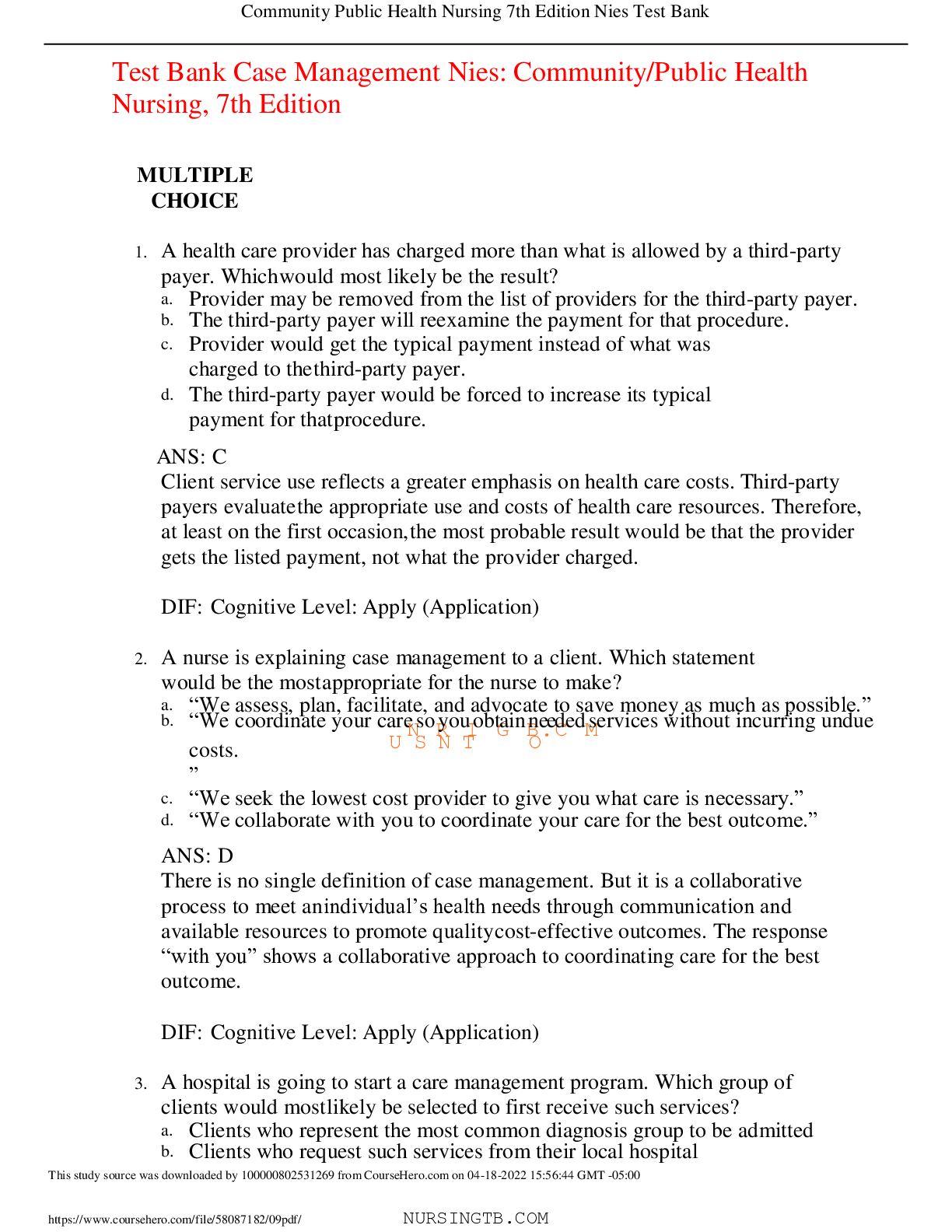
Reviews( 0 )
Document information
Connected school, study & course
About the document
Uploaded On
Apr 19, 2022
Number of pages
14
Written in
Additional information
This document has been written for:
Uploaded
Apr 19, 2022
Downloads
0
Views
45










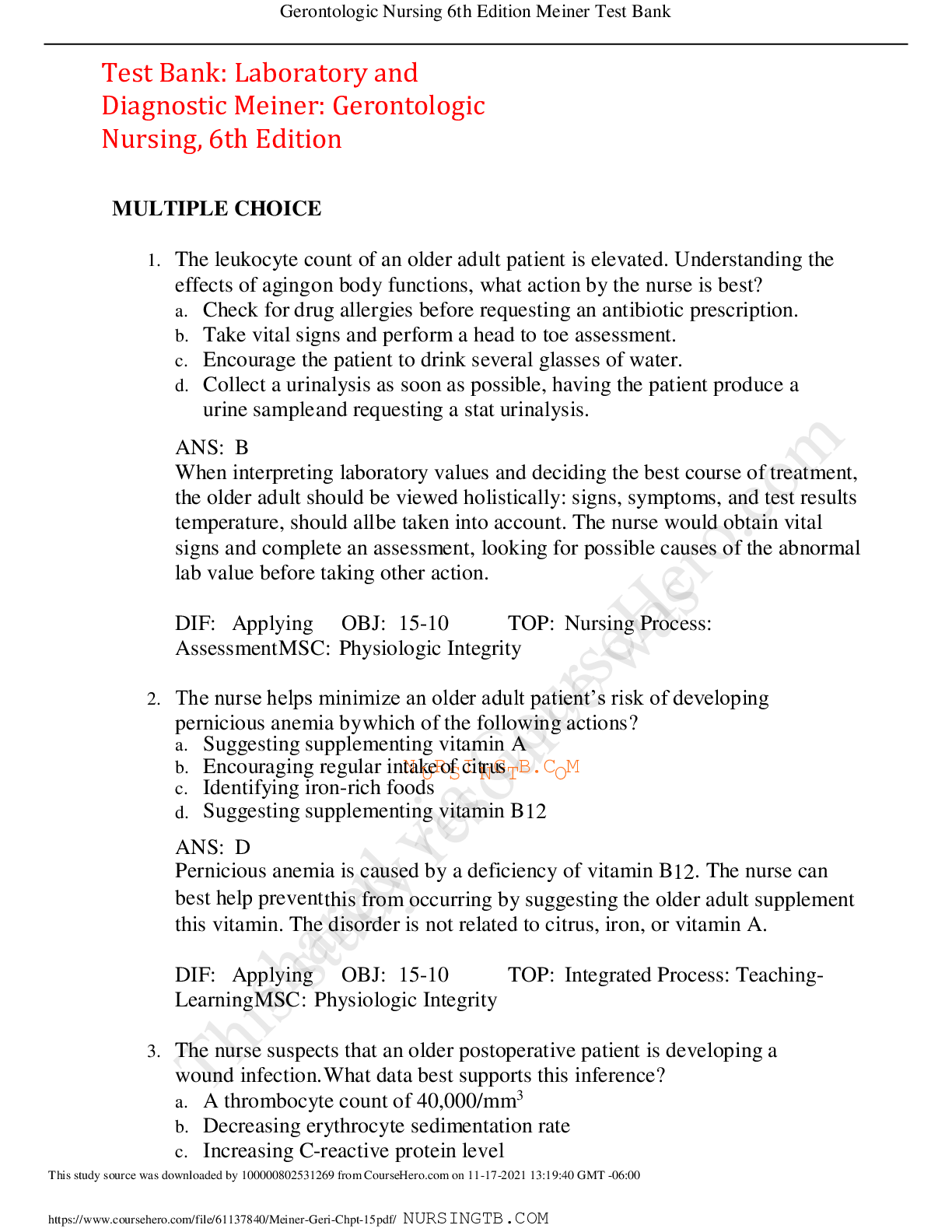




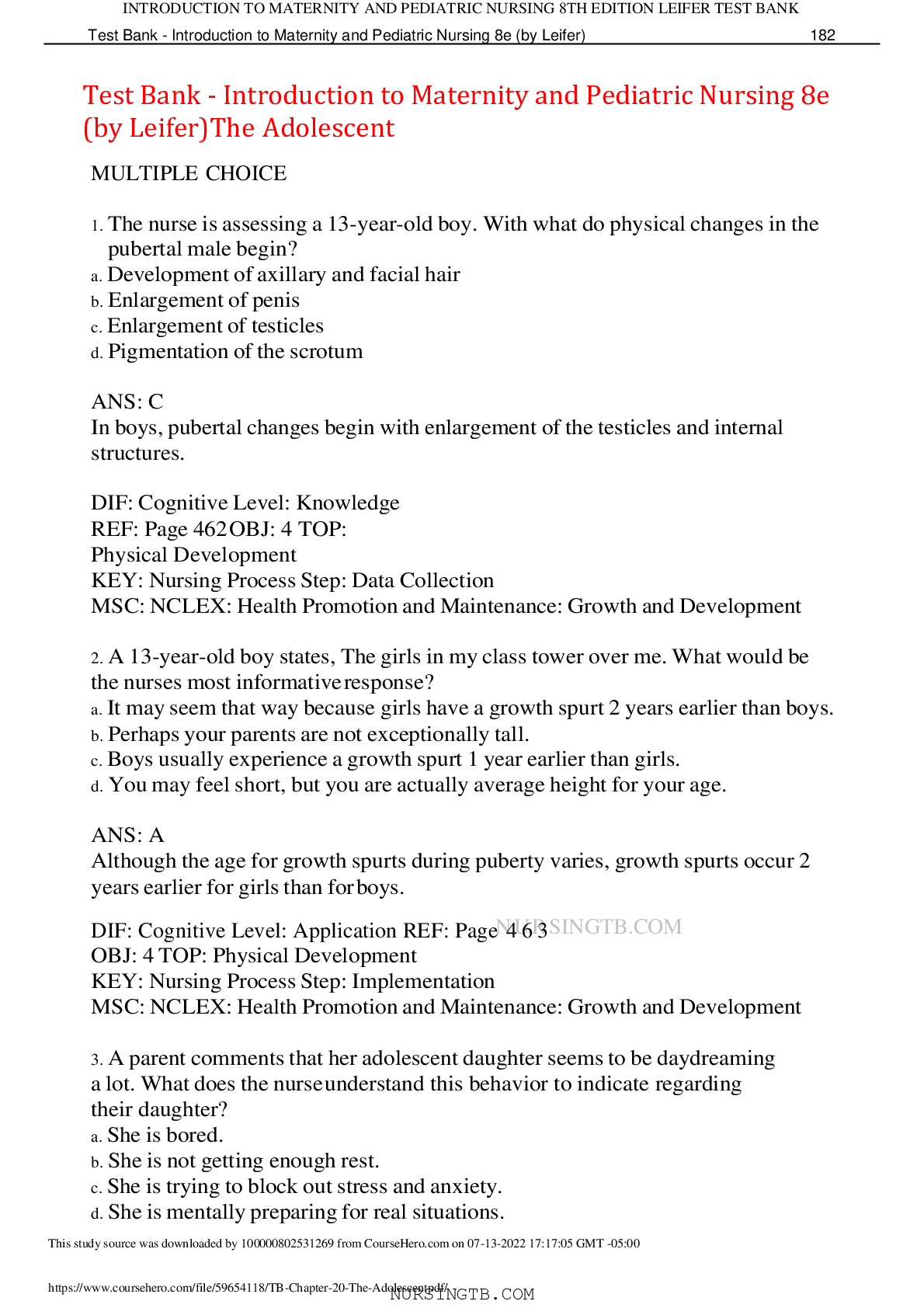
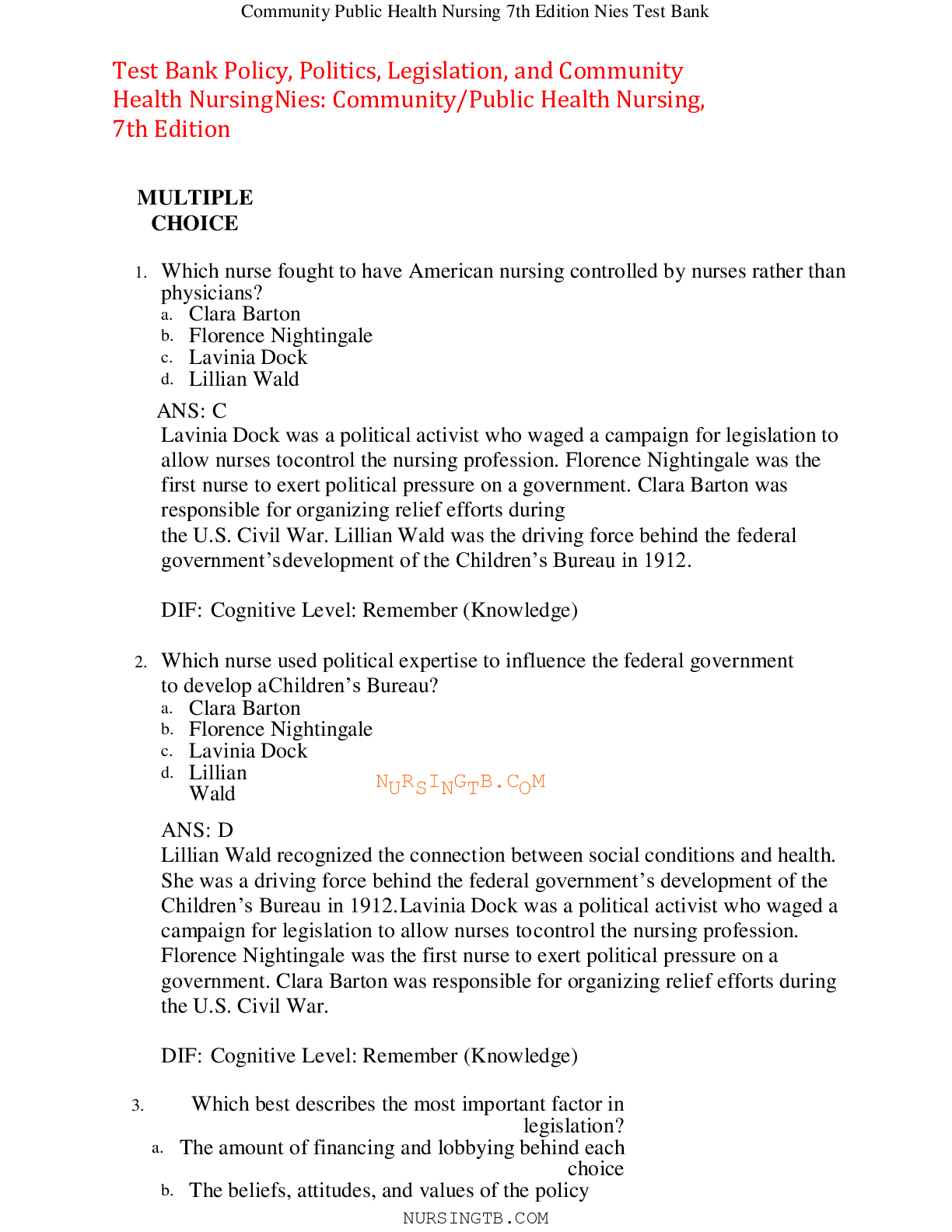

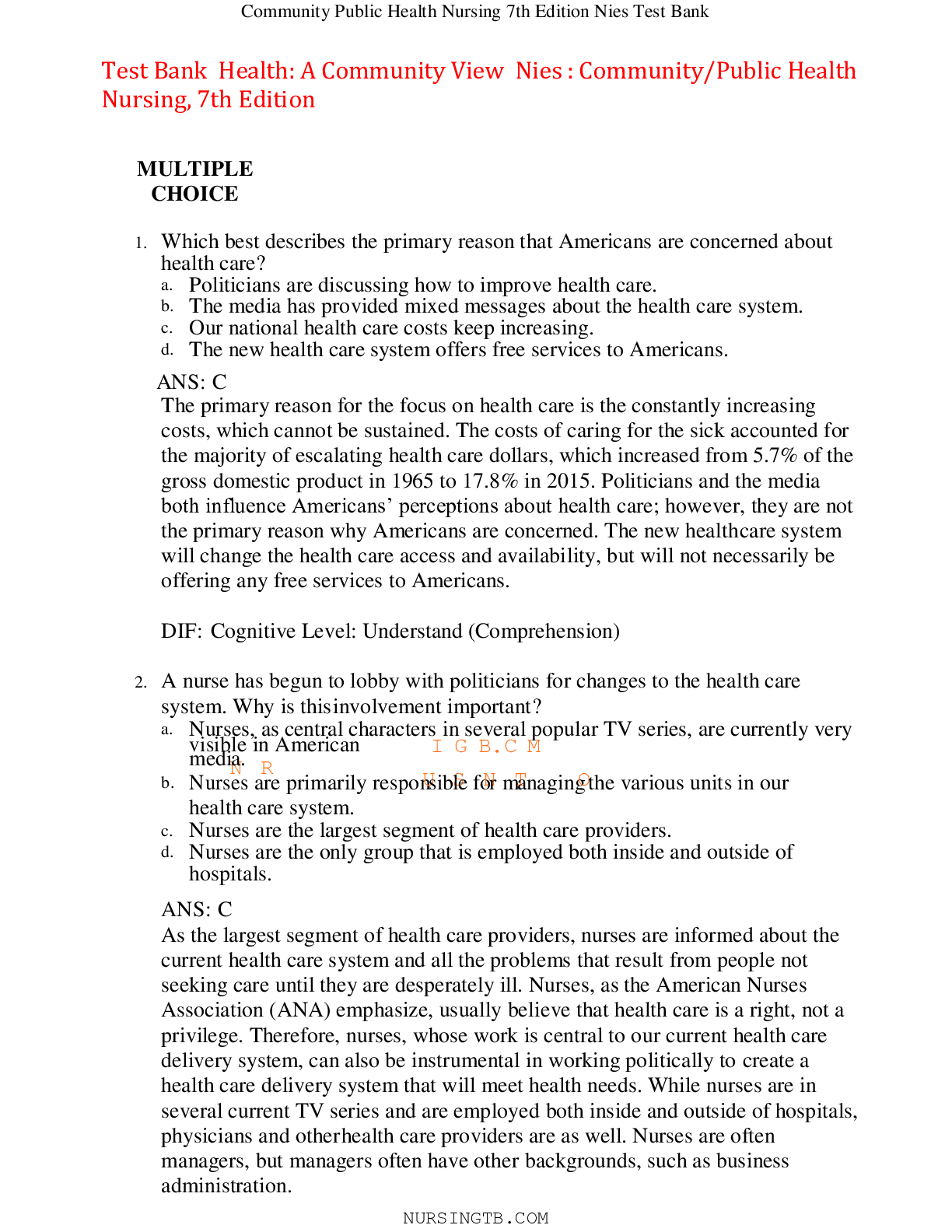
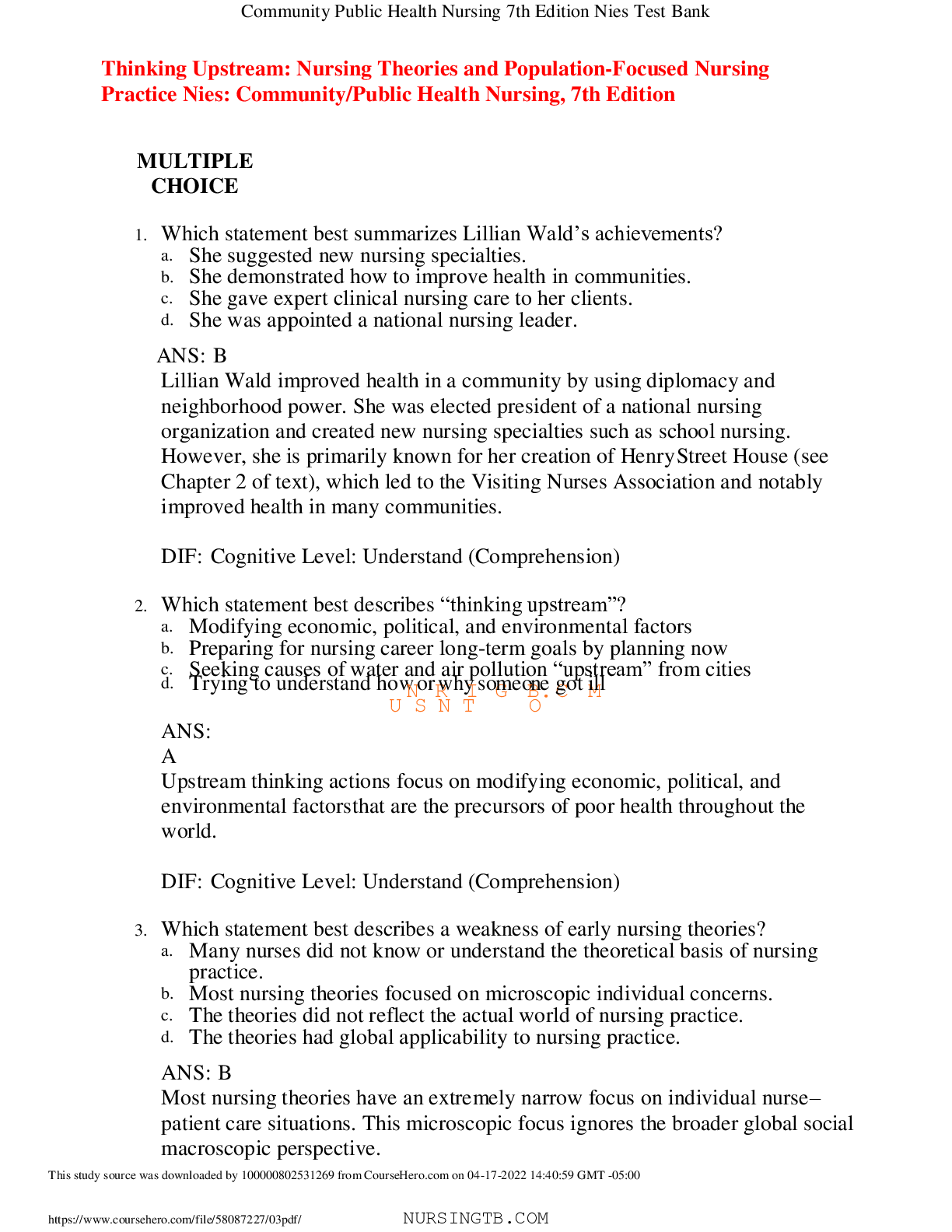


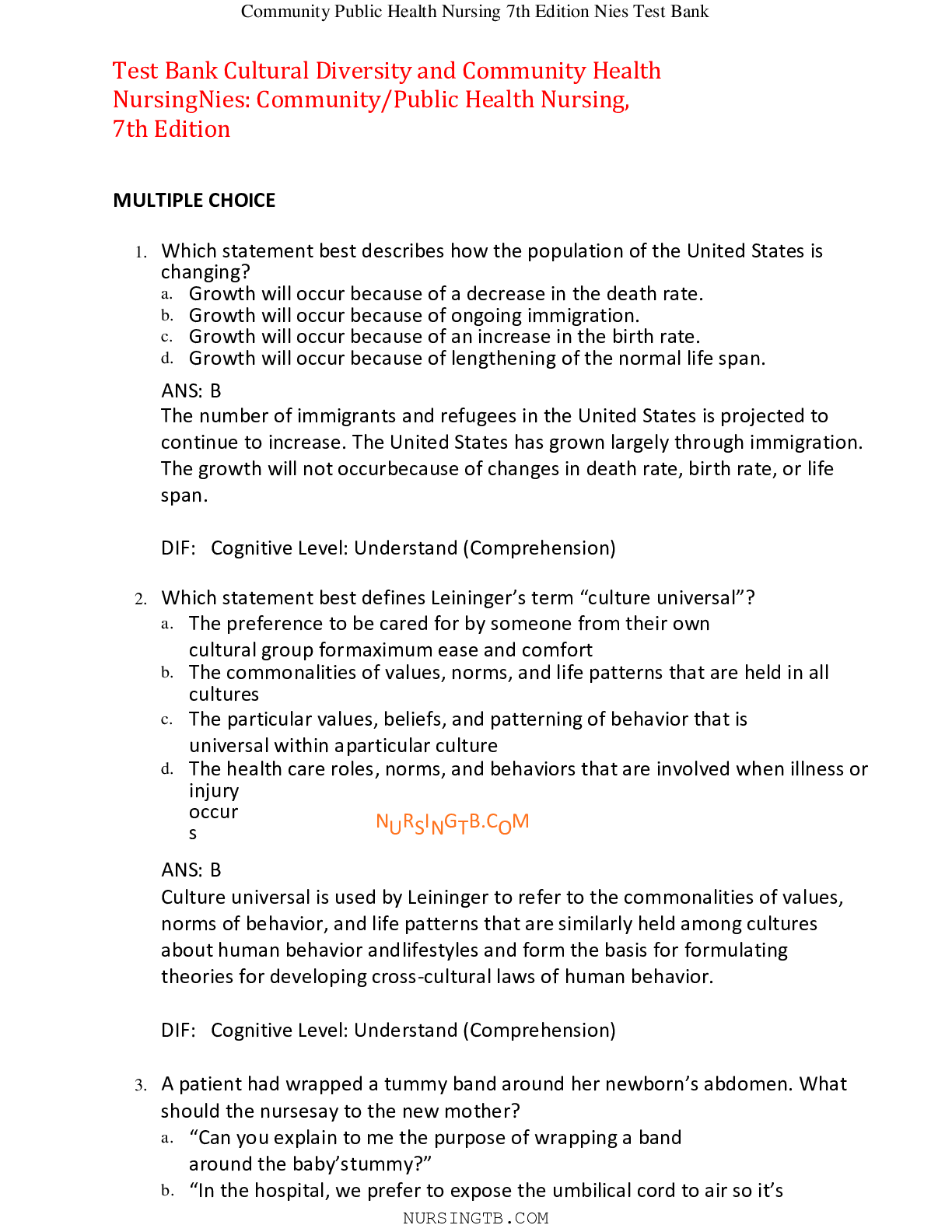

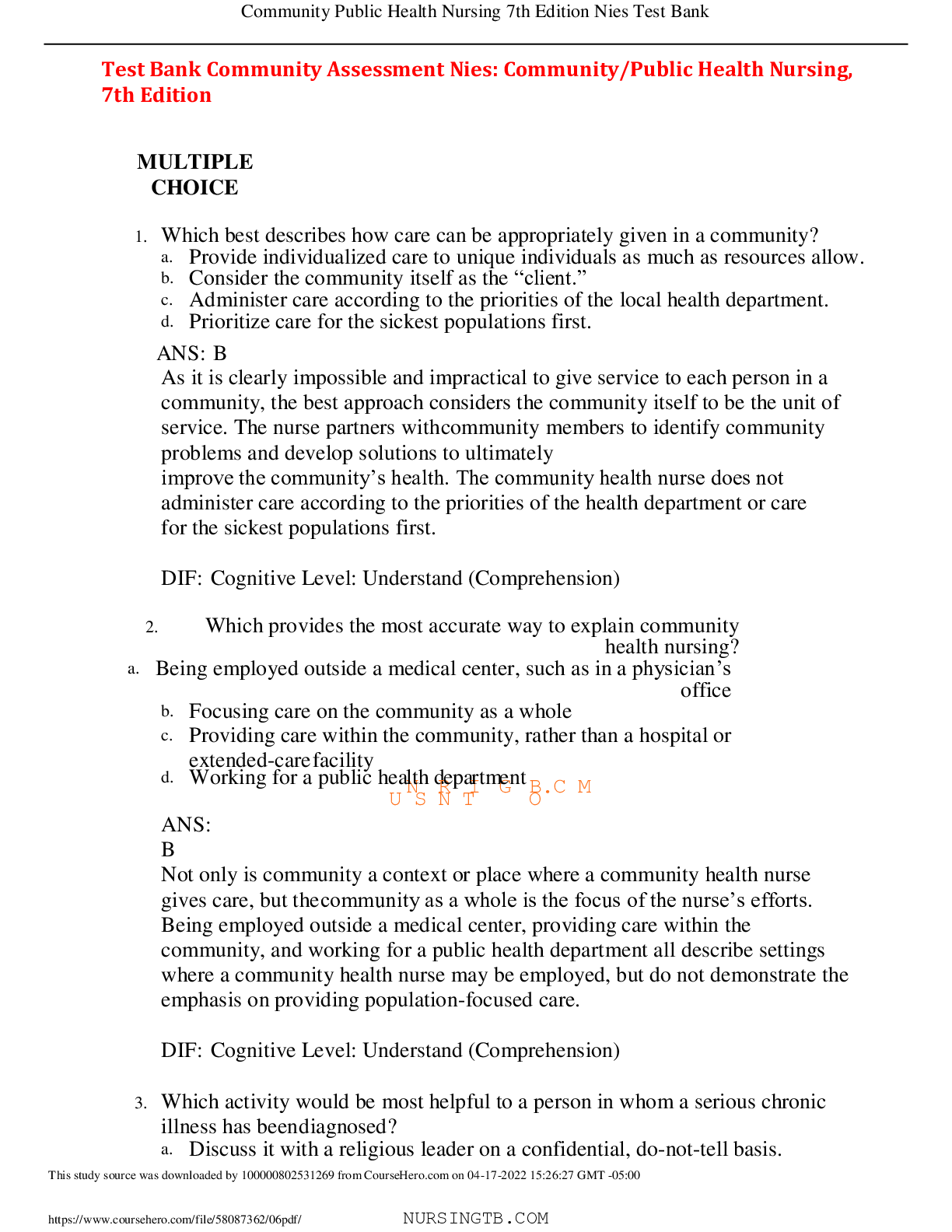
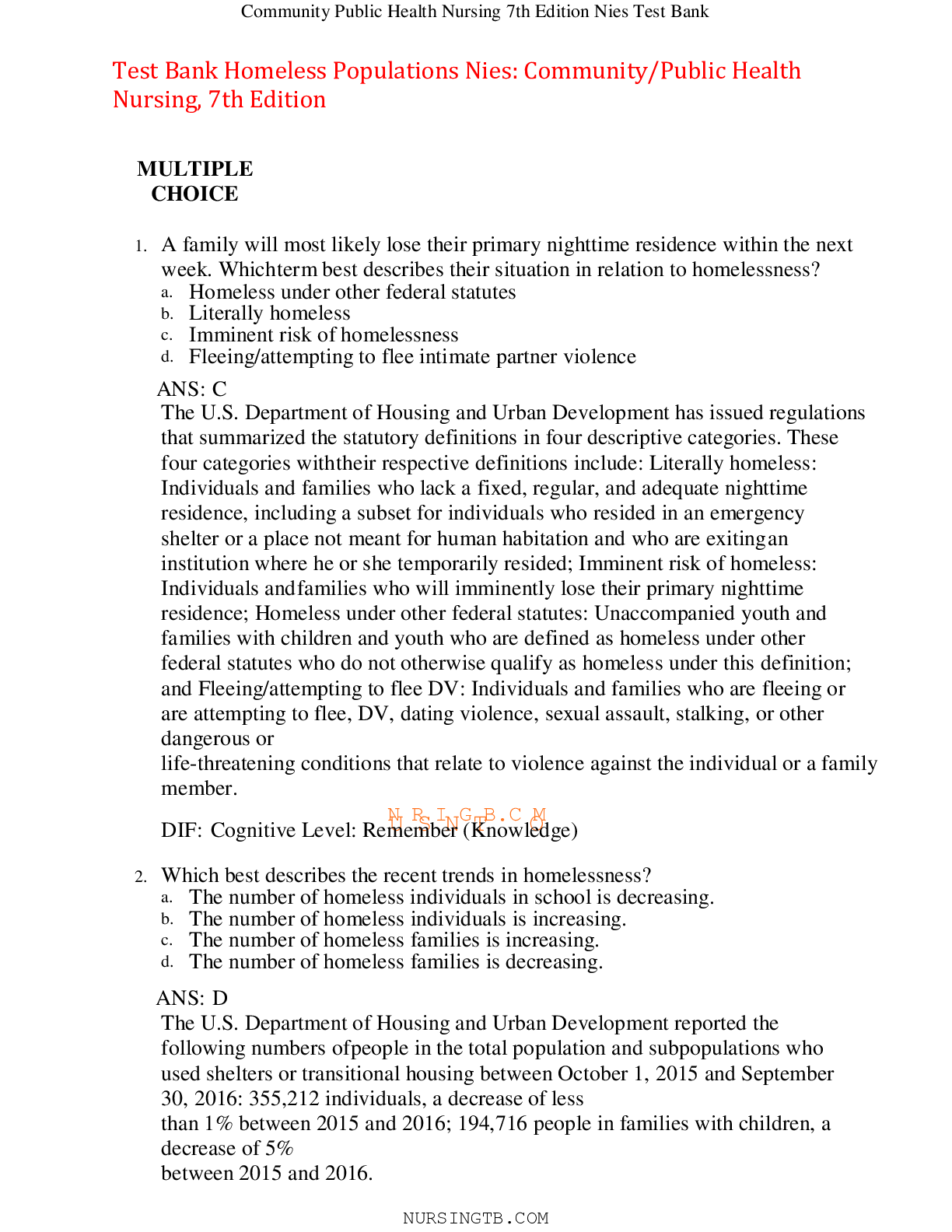

.png)
